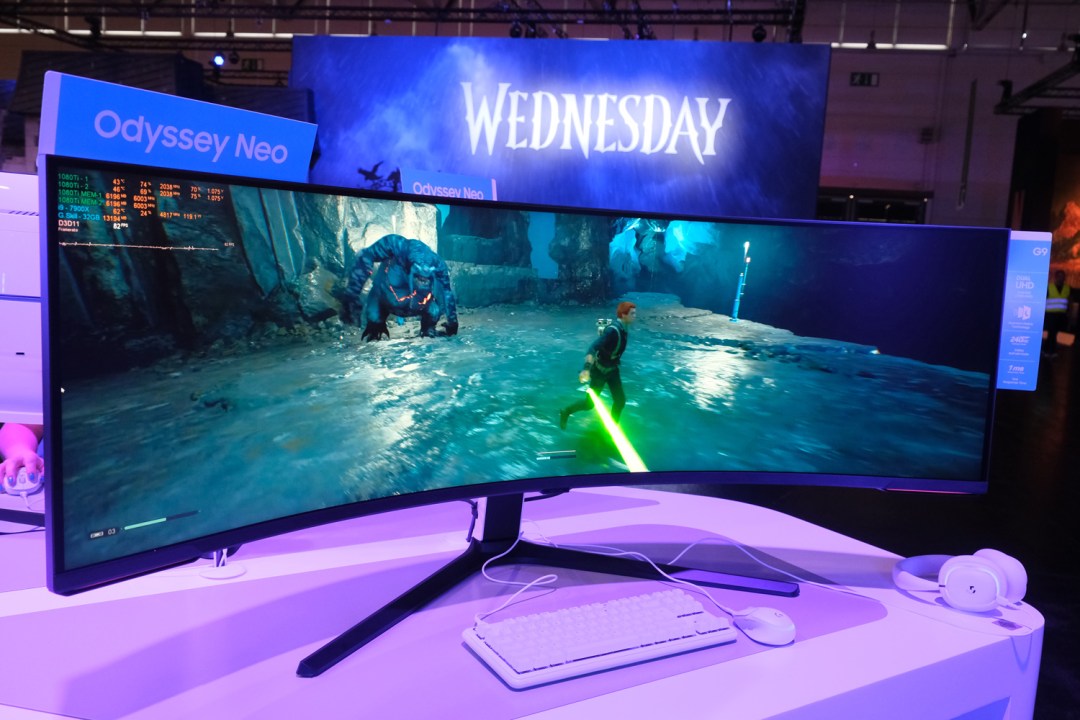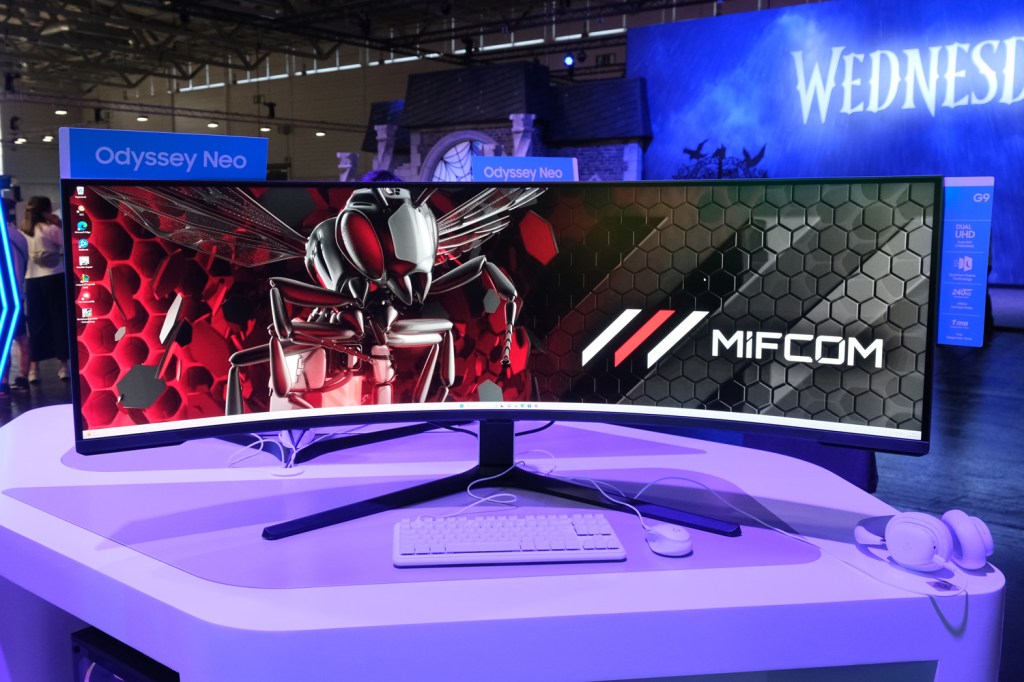Samsung Odyssey Neo G9 57in hands-on review: the bigger picture
57in ultrawide delivers incredible detail - if your graphics card plays ball

Dual UHD resolution. Sounds innocent enough, right? Nope. It’s a bit like calling a vicious Pit Bull dog “Fluffy” or “Cuddles”. Do a little digging and you’ll realise Samsung’s latest top-tier gaming monitor maxes out a colossal 7680×2160. That’s over 16 million individual pixels – and at the panel’s maximum 240Hz refresh rate, your poor graphics card has to churn out 39 billion of the things every second. The Odyssey Neo G9 is huge in other ways, too.
The 57in ultrawide is the equivalent of two UHD monitors combined, and needs a DisplayPort 2.1 connection to deliver its full potential. It’s overkill for all but the most demanding of gamers, or anyone looking to streamline a dual- or even triple-monitor setup. It was first announced at CES in January, but this year’s Gamescom show was our first chance to check it out in person, alongside the second-gen Odyssey Ark monitor. Is it the ultimate desktop upgrade? At $2,499/£2,200, it had better be…
Design & build: I don’t think you’re ready for this UHD

The Odyssey Neo G9 is a statement piece no matter which way you’re looking at it. You’ll need more than 1.3m of desk space to make room for it, and that dramatic 1000R curve means it also demands about 50cm of depth. Sensibly the stand uses splayed feet that mirror the curve of the screen, so it doesn’t take up any more room than it has to.
There’s a generous 120mm of height adjustment, and a good amount of swivel and tilt too. Just keep in mind the ultrawide aspect ratio works best when you’re directly facing the screen, rather than at an angle to it. At 19kg fully assembled, we’re also glad we didn’t have to mate screen to stand ourselves and could just try it out in situ.
It looks all black from the front, with reasonably svelte bezels that didn’t prove distracting during our short gaming session. Head around back, though, and you’ll see the same glossy white finish found on Samsung’s other top-end gaming monitors. It has real spaceship vibes, especially once the circular Core Lighting LEDs spring into action. They’re full RGB and have a bunch of baked-in animations that can bathe your wall in colour.
Features & interface: so much screen space



The single DisplayPort 2.1 input at the rear of is the Odyssey Neo G9’s special sauce; it’s the only way to get the screen’s native resolution and maximum refresh rate, with the three HDMI 2.1 inputs topping out at 60Hz. Any gadgets with a DisplayPort 1.4 output would be similarly limited, with factors like display stream compression or chroma subsampling further muddying the waters.
Right now the only graphics cards with DisplayPort 2.1 are the AMD Radeon 7900-series (although the firm says future RDNA3 cards will also be DP2.1-compatible), with nothing from the Nvidia or Intel camps. Use one of those cards and the display driver is unlikely to let you select anything higher (although we’re waiting for confirmation from AMD and Nvidia on that point).
Of course, even a Radeon RX 7900XTX is going to struggle to hit such high frame rates on newer, more demanding titles, even with trickery like Fidelity FX Super Resolution (FSR) upscaling. But monitors like this give GPU makers something to aim for, right?
A near-8K ultrawide screen with a 32:9 aspect ratio is good for more than just gaming, of course. You can easily put four documents or windows side-by-side, and the picture-in-picture and picture-by-picture modes let you check out multiple sources at once. Each option was just a few taps away using the directional buttons built into the centre of the bottom bezel. The Odyssey Neo G9 can also switch between active sources automatically, saving you from manually swapping between inputs.
We like the addition of a USB hub to tame all your peripheral cables, and the KVM switch option lets you stick. to just one keyboard and mouse when working across two computers.
What it doesn’t have are the Tizen smarts seen in the Odyssey Ark. That’s fair enough: Samsung reckons you’ll mainly be sat in front of this giant screen, rather than laid back on the sofa.
Picture quality: bright as you like



The Odyssey Neo G9’s high resolution and refresh rate really were a treat for the eyes, with astonishing definition and clarity across the board. The way the wide aspect panel curves inwards really helps you feel surrounded by it, even when you’re sat a good distance away. Samsung says response times are a whip-crack-quick 1ms (grey-to-grey), and though we weren’t able to test it, there were no obvious signs of smearing.
AMD’s FreeSync Premium Pro adaptive refresh tech should guarantee there won’t be any frame tearing, and will be very important for anyone trying to game at the demanding native resolution. We’d want to spend a lot more time in front of one before passing final judgment, though.
Samsung’s gaming monitor division has dipped a toe or two into OLED, but the Neo G9 sticks with the firm’s (slightly) more attainable mini-LED backlight tech. It’s able to deliver a claimed 1000 nits peak brightness, and conforms to VESA’s DisplayHDR 1000 standard. Things looked wonderfully bright on Samsung’s Gamescom booth, doing real justice to some of the demo footage we tried. The VA panel also has a matte finish, which handily diffused indirect light reflections.
With more than 2000 local dimming zones, we were also impressed with the level of detail on show in dark scenes, without much accompanying grey washout from the backlight. It’s not going to be able to match OLED entirely for deep blacks and epic contrast, but it did a fantastic job during our short session.
Samsung Odyssey Neo G9 initial verdict



Just when you thought Samsung had reached the ceiling for bonkers gaming monitors, the Odyssey Neo G9 arrives. There’s nothing else quite as expansive, vision-filling or immersive for gaming, and it could genuinely replace a three-monitor setup. KVM smarts sound promising for those working across multiple computers, too. Oh, and let’s not forget the mini-LED panel is rather stunning too, if not quite as impactful as OLED in certain situations.
Right now support is so limited there’s only a handful of graphics cards able to support it fully, although even that will likely struggle to game at such an epic resolution and refresh rate. The Neo G9 is plenty future-proof, though, so while it’s an expensive upgrade right now it should happily live on your desk for years to come. – If you have the space and the budget for it, that is.


